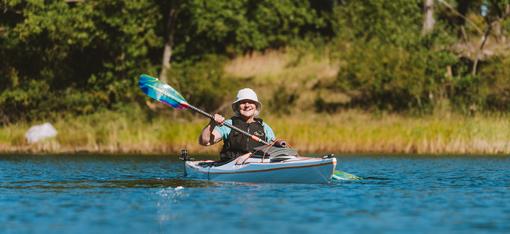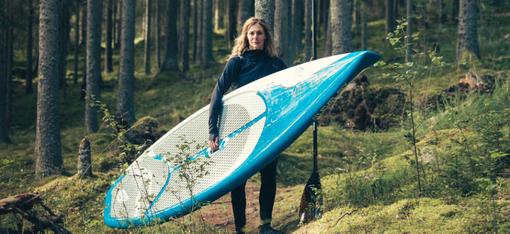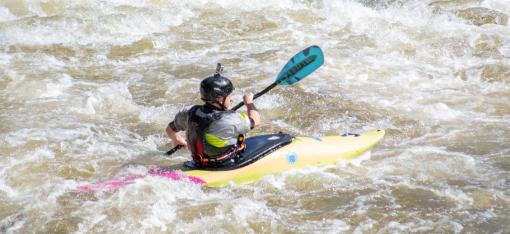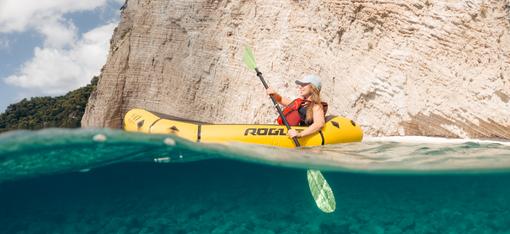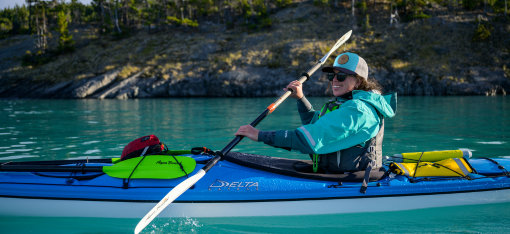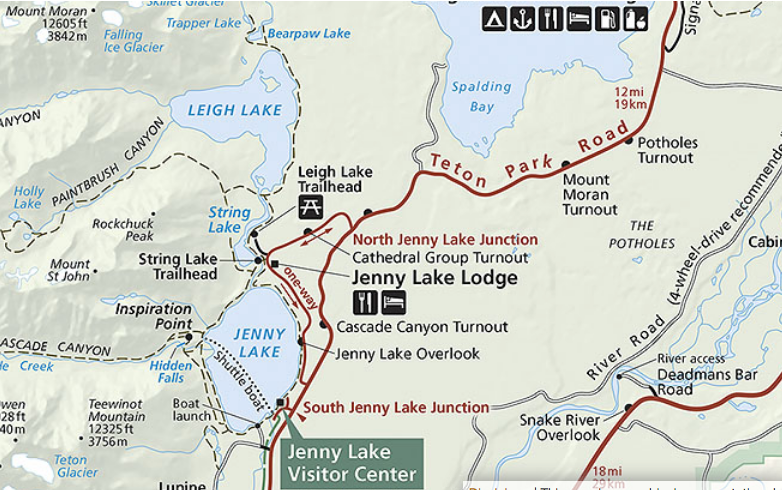Paddling in Grand Teton National Park

by Sharon Brodin
The crystal-clear lakes of Grand Teton National Park are begging to be paddled—not just looked at and photographed! One of the most picturesque spots in North America, the Teton Range hosts several of these lakes with stunning mountain views.
Grand Teton National Park is located in the northwest corner of Wyoming, directly south of Yellowstone National Park (they share a border). The park lies north of the town of Jackson and the popular Jackson Hole Ski Resort. It includes part of the Grand Teton Mountains as well as the flats just to the east of the peaks.
My family and I have taken two family road trips to this park so far. We're reminded each time of its incredible beauty, ruggedness and opportunity for outdoor adventure.
Most of the visitors, though, seem to flood the campgrounds, overlooks and closest hiking trails (not unusual in our national parks, really). Relatively few take advantage of the great paddling offered on the park's scenic lakes and the Snake River that winds its way down the flats.
The Best Places to Paddle
Of the more than 100 lakes in the Park, ten are available for boating. Of those ten only two allow motorized boats. That’s great news for those of us who love the quiet!
You’ll be rewarded with amazing views of the surrounding mountains and canyons as you paddle across these pristine lakes. The famous peaks of Grand Teton and Mount Moran are easily seen from most of these lakes.
Here's a breakdown of the full map of the Park to highlight the lakes open to kayaking, canoeing and paddleboarding:
Jackson Lake
On the north end is Jackson Lake, by far the largest lake in the park at 25,540 acres. Because of its size, you'll want to be aware of forecasted weather conditions.
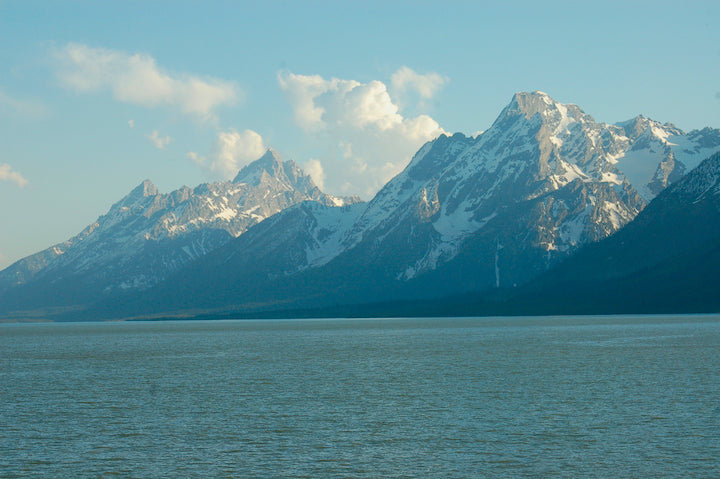
Jackson Lake with the Teton Range on its western shore
We've been there when the entire lake was dead calm for days in a row. But with wind, it'll definitely have good chop and probably whitecaps. In that case, your best bet would be to stick to the smaller bays like Half Moon Bay and Colter Bay near the marina where it's more sheltered. It's not hard to find great paddling spots with unobstructed views of the mountains just across the lake.
Jackson Lake is the only lake in the park that allows sailing, windsurfing and water skiing. If you have your own boat, you'll have much more freedom to choose access points and time of day.
The earlier in the morning you can get out the more likely you are to find calm waters and fewer of the faster, bigger watercraft out there too. And the easier parking close to the launch will be.
(Keep reading for rental options)

Other Paddling Lakes
If you have your own boat consider Two Ocean Lake or Emma Matilda Lake. You’ll be able to see a view of the peaks over the treetops, but not the dramatic views you get from the other lakes. But you won't have the crowds of the other lakes either. Take Pacific Creek Road off Highway 26, then a left on the dirt road that takes you to the Two Ocean Lake picnic area. Emma Matilda will involve a portage as there's no vehicle access, the best way (and shortest) being the trail off Pacific Creek Rd.
The most popular lakes to canoe, kayak and SUP in the park are Jenny Lake, String Lake and Leigh Lake (shown below). They’re also very accessible and lay at the base of the Teton Range’s biggest peaks. They're incredibly scenic!! There’s a well-traveled 100-yard portage connecting String and Leigh Lakes. And tiny Bearpaw Lake, just a short portage north of Leigh Lake, is also open to paddling if you'd like to go for the whole chain.
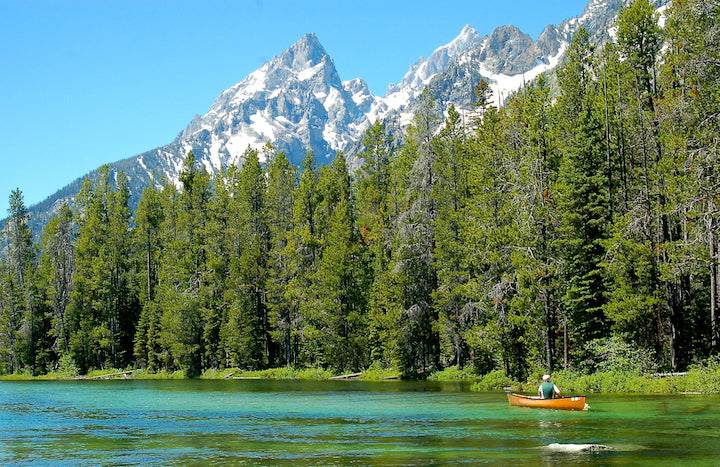
A solo canoeist on String Lake
The rentals on Jenny Lake have to stay on Jenny (which is well worth it), so if you'd like to try the others you'll need your own boat. There's a large parking lot at the String and Leigh Lake trailhead area but it fills up quickly on summer days. So plan to arrive early morning so you don't have to carry your boat very far to launch.
Further south, Bradley, Taggart and Phelps Lakes are open to paddling. Since all three require portaging in on one of the hiking trails, you may be on the water all alone if you decide to make the trek yourself. And, of course, you'll need something light enough to carry up the trail to reach them. Ultra-light inflatables excel here, especially packrafts.
Floating the Snake River
The Snake River is the only river in the park open to watercraft. It flows through from north to south through the entire length of the park. In fact, Jackson Lake is a reservoir created from the Snake River by the Jackson Lake Dam.
Like any river, water levels vary over the course of the paddling season and weather patterns so check that out before you plan your trip.
The National Park Service provides this very helpful page about taking a paddle trip down the Snake. Read that carefully before making your plans. Unless you're an experienced river paddler stick to the 5-mile beginner stretch between Jackson Lake Dam and the Pacific Creek launch (which includes the popular and very scenic Oxbow Bend section).
Experienced river kayakers and canoeists with good navigation skills can tackle the two 10-mile intermediate routes. One is on the north tip of the park and the other is from Pacific Creek to Deadmans Bar. Further south requires advanced river paddling skills, especially in high water.
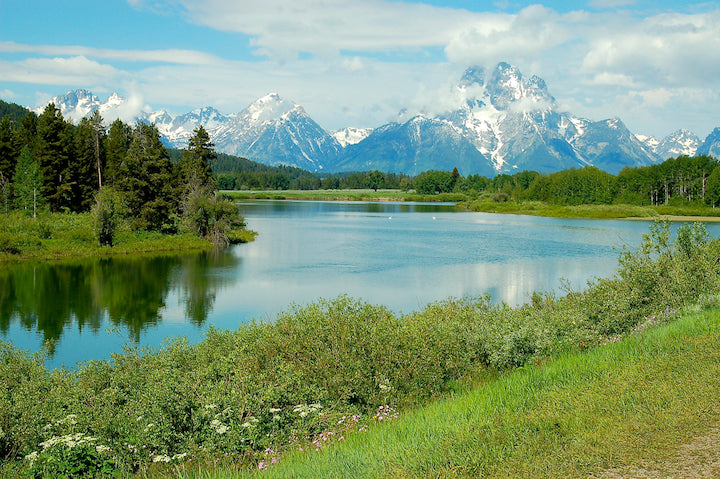
Oxbow Bend of the Snake River in Grand Teton National Park
The Best Times to Paddle
As in most places, you’re more likely to have less wind in the mornings and evenings. Also, as is typical in mountain areas, it’s not uncommon for an afternoon rain shower or thunderstorm to move in. Get a forecast before you head out. You may not be able to see the clouds moving in from the west due to 7,000 feet of mountains in your way!
On our most recent trip we hiked on the String and Leigh Lake Trails first, and then went to Jenny Lake for some canoeing. Unfortunately, while String and Leigh were calm, the wind was whipping across Jenny, producing plenty of white caps. We’ve done enough high-wind canoeing in Minnesota to know it wouldn’t be fun, so we decided to opt-out. Next time we’ll get down there earlier in the day.
If you want to be able to swim as well as paddle, shoot for July or August when the water “warms up.” (Being glacier-fed alpine lakes, they’re never really very warm!)
Paddling is ideal in the summer months, after ice-out. July and August are the busiest months in the Park for visitors, too. So if you prefer fewer people, shoot for June or September. As already mentioned, get out early in the day as the parking areas start to fill up by mid-to-late morning!
Rent or Bring Your Own Boat?
You’ll have the most flexibility by bringing your own kayak, canoe or paddleboard when you visit the Tetons. No waiting in rental lines or following strict time guidelines. There are a couple of things you need to know, though, if you decide to bring your own boat:
- Grand Teton Boat Permit—This is $25 for non-motorized boats, including kayaks, canoes and paddle boards (2023 price).
- Wyoming AIS Decal—$15 for non-motorized non-Wyoming residents to show your boat has been inspected for aquatic invasive species (AIS). If yours is an inflatable craft under 10 feet long or any type of paddle board, you're exempt from this (as of 2023).
Get more information on both these permits here.
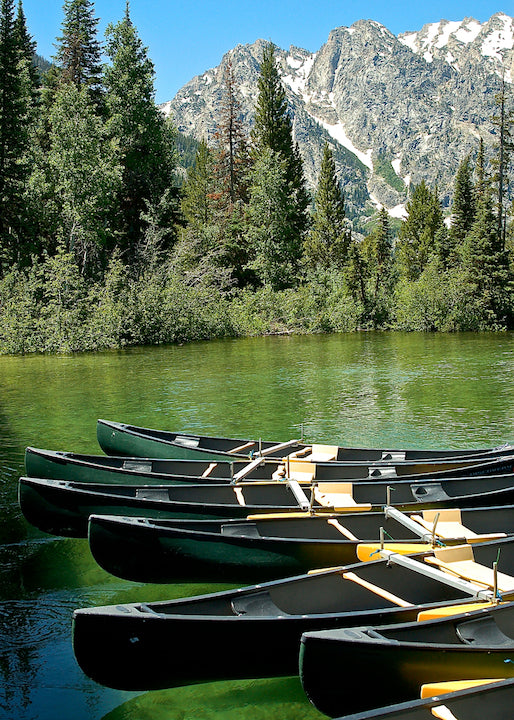
Rental canoes at Jenny Lake
Canoe and kayak rentals in the park are operated by private permitted companies. You have a couple of options (all show 2023 prices):
- Jenny Lake—Nestled against the tall peaks and much smaller than Jackson Lake, this jewel is a hugely popular destination in the park. Rent canoes or double kayaks from Jenny Lake Boating for $25/hour or $100/day.
- Jackson Lake/Colter Bay—Several bays and an interesting shoreline to explore with gorgeous mountain views. Rent a canoe, single kayak or tandem (double) kayak from Colter Bay Boat Rentals for $30-$45/hour with a 2-hour minimum.
- Jackson Lake/Signal Mountain—On the south end of Jackson Lake, Signal Mountain Lodge rents kayaks. Rates start at $29/hour for a single and $39 for a tandem. Daily rates are also available.
All of these rental places operate first-come, first-served.
There are a couple of rental options that operate outside the Park, too:
- Superior Paddlesports in Jackson rents paddle boards and inflatable kayaks and will deliver them to your paddle destination: Jackson Lake, Jenny Lake or String Lake. That's a wonderful convenience! Daily and multi-day rentals are available. Accessory add-ons like bear spray are available too.
- Rendezvous River Sports in Jackson offers the biggest selection of rental boats in the area. You have your pick of canoes, kayaks, paddleboards or packrafts and can rent for one day or up to a week. You can also rent accessories like dry bags, wetsuits and more. Renezvous also offers kayak tours on Jackson Lake and the Snake River for 2-4 days. Prices for these tours include the gear and meals.
- Leisure Sports in Jackson rents kayaks, canoes and paddle boards by the day or for several days. Several accessories are available including a hitch, wetsuits and bear spray.
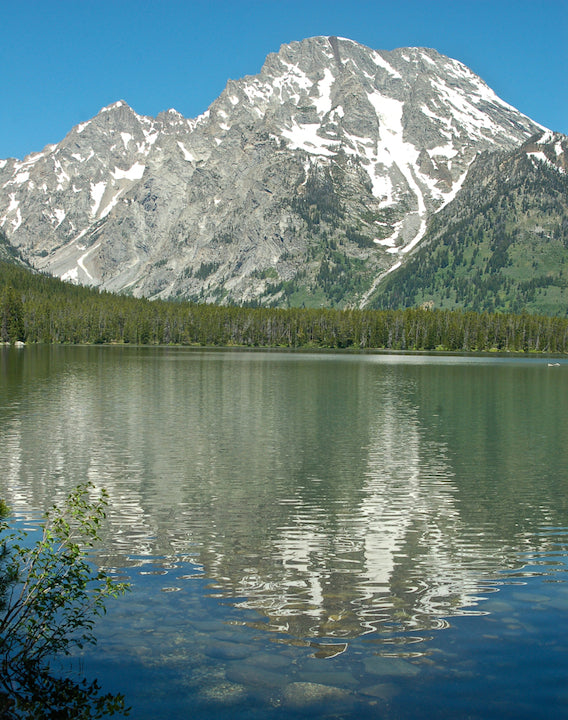
Leigh Lake with Mount Moran towering behind
Know and Follow the Park Rules
Besides being vigilant about aquatic Invasive species, Grand Teton National Park has other park rules you'll want to know about when you decide to paddle.
Like in all our national parks, there are strict rules about pets throughout the Park including in the campgrounds, on the trails and in/on the water. They're not allowed on any trails, front country or backcountry. They're not allowed at the swimming beaches or in boats on any of the lakes except Jackson Lake. But you'll need your own boat, as the rental companies don't allow pets in their boats. It's really a good idea to leave your pet(s) at home when you visit the Tetons.
Remember you’re in bear country. Never leave food in your boat if you decide to leave it on shore unattended. Here are the Park’s bear guidelines.
Practice paddling safety at all times. This includes wearing your life jacket and not getting on waters above your skill level. It's also important you respect the very cold water found in these lakes. Hypothermia is a real danger if you end up in the water for more than a few minutes. Paddle boarding novices, either stick close to shore or wear a wet suit…or both.

People come from all over the world to see the Grand Tetons. You won’t regret adding it to your list of must-see places. When you do, consider paddling at least one of its beautiful lakes for a one-of-a-kind experience.
All photos courtesy of Sharon Brodin
(This was first published in 2017 and has been updated)

